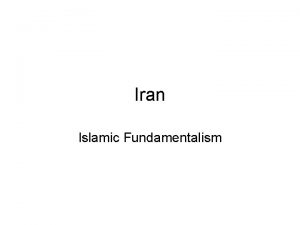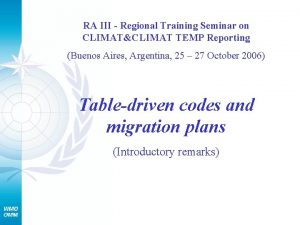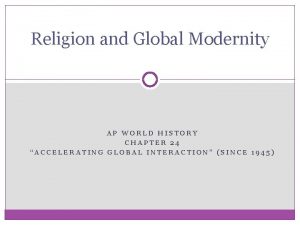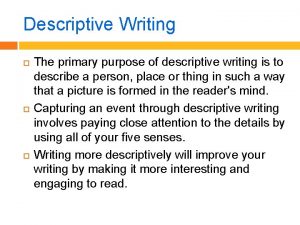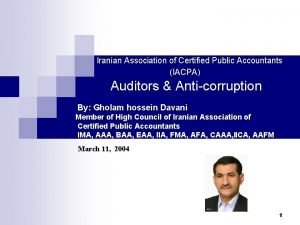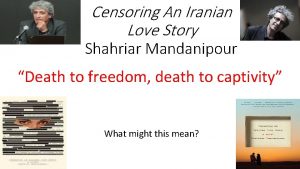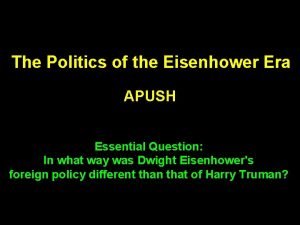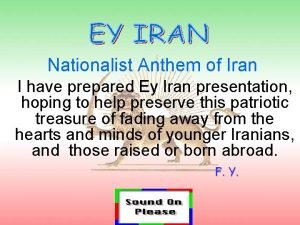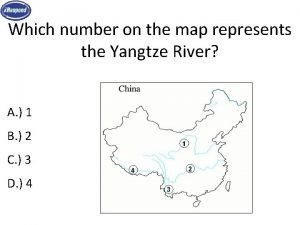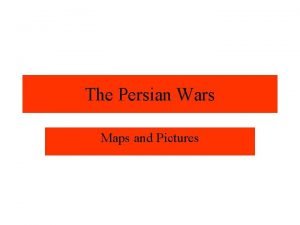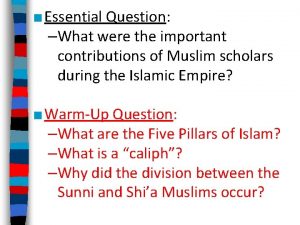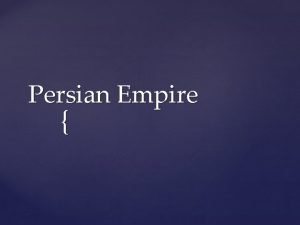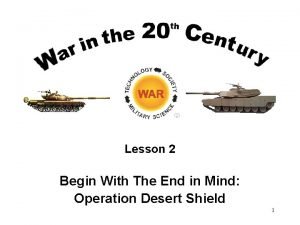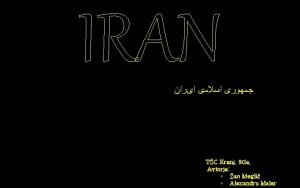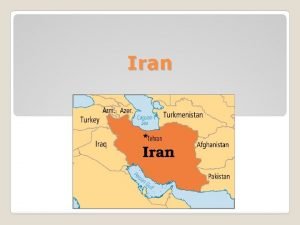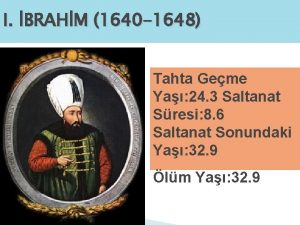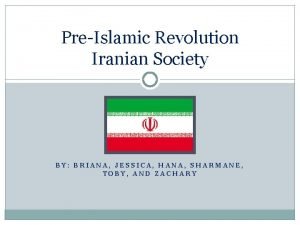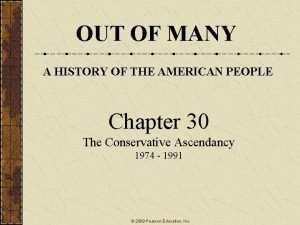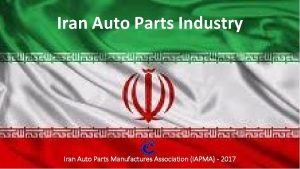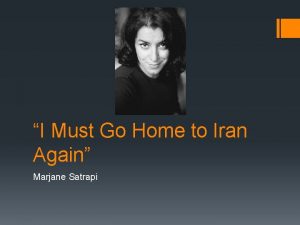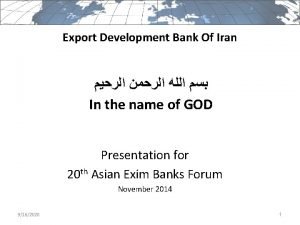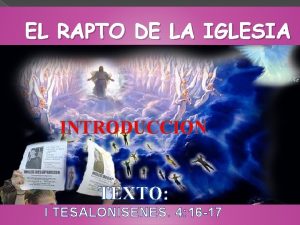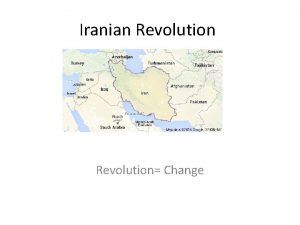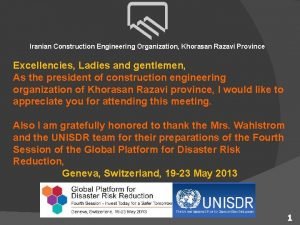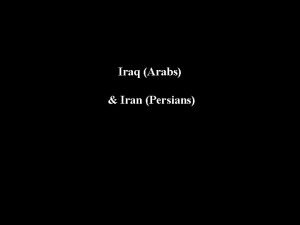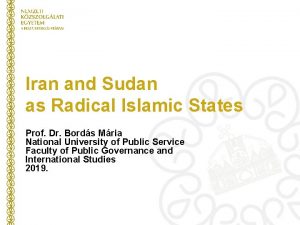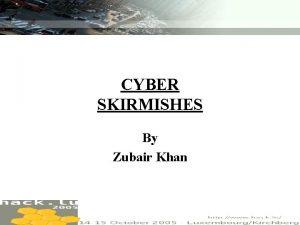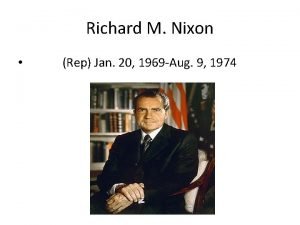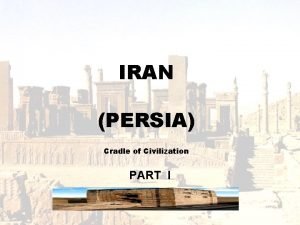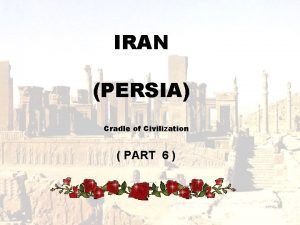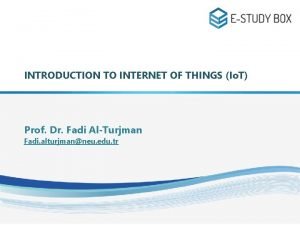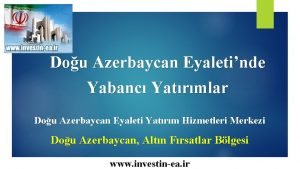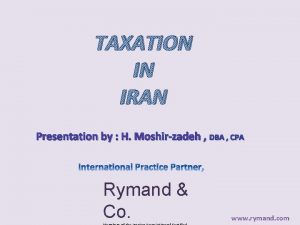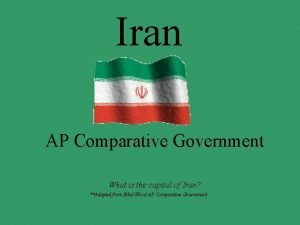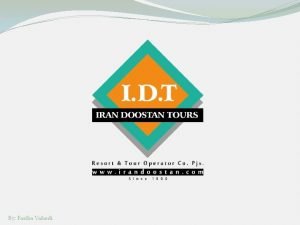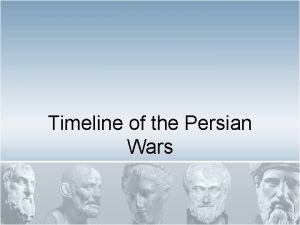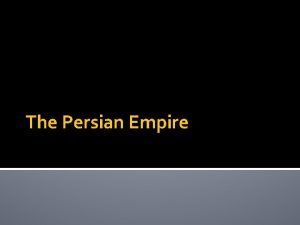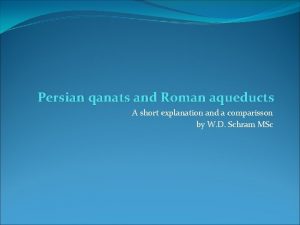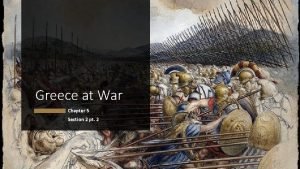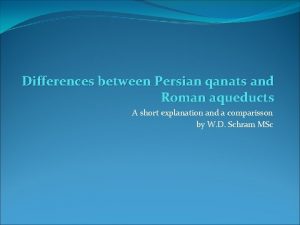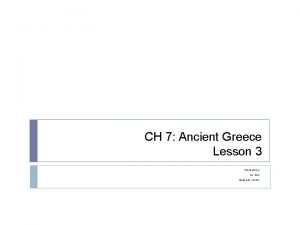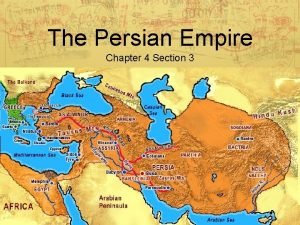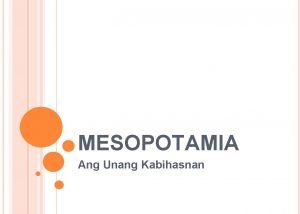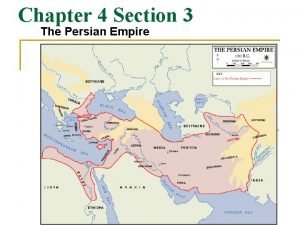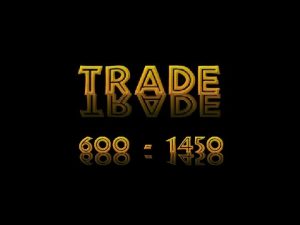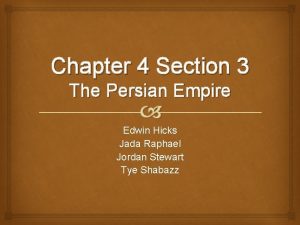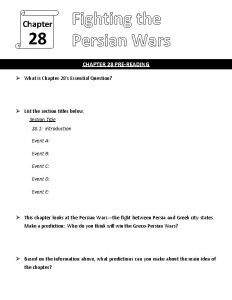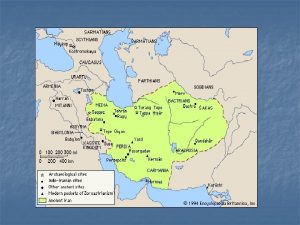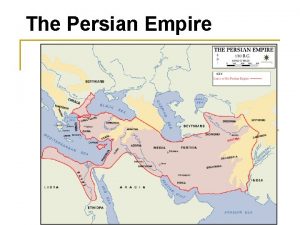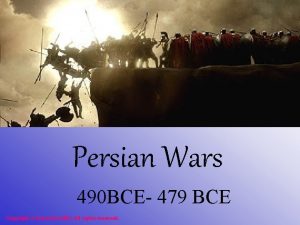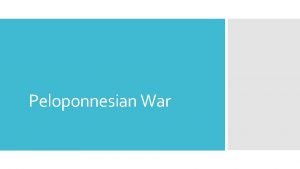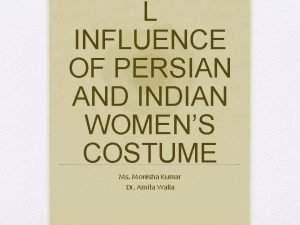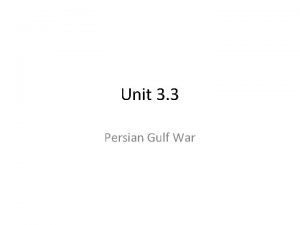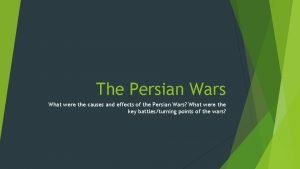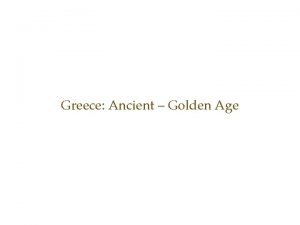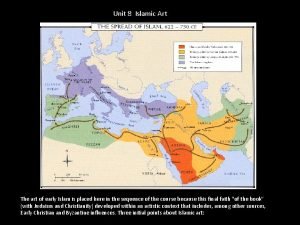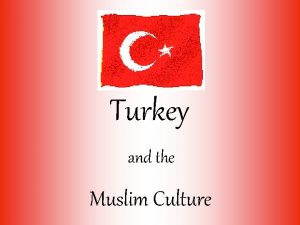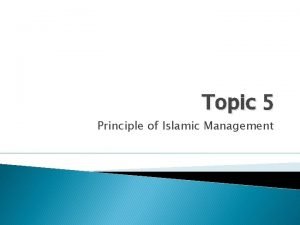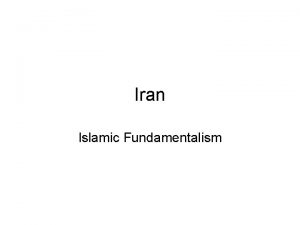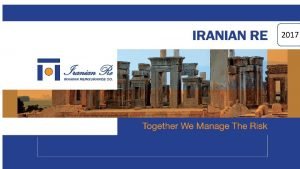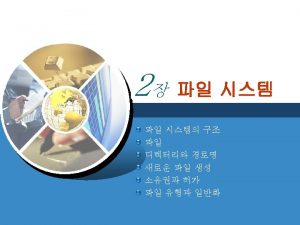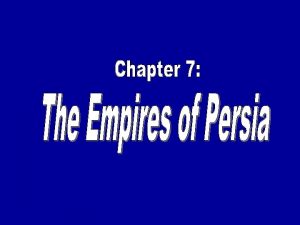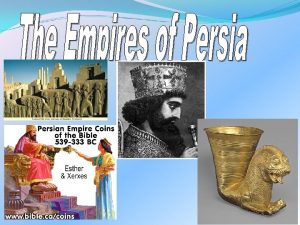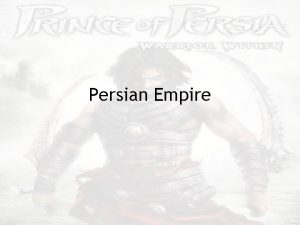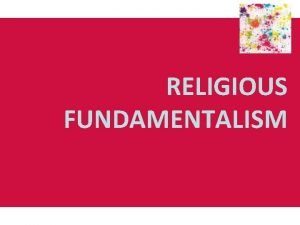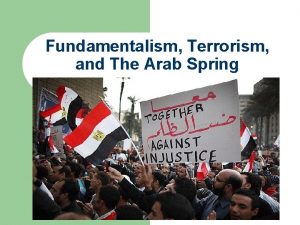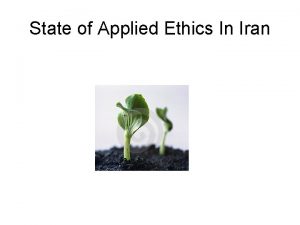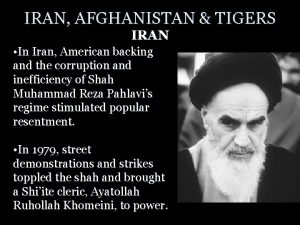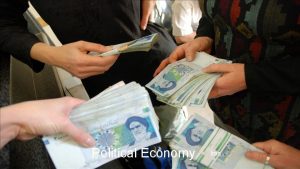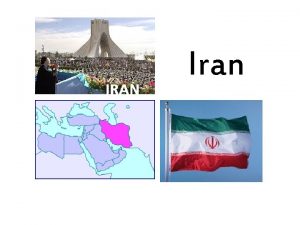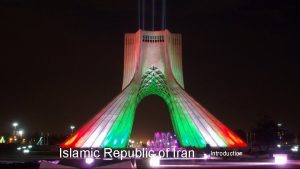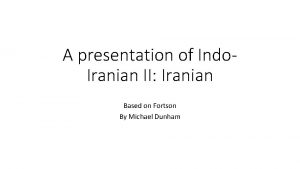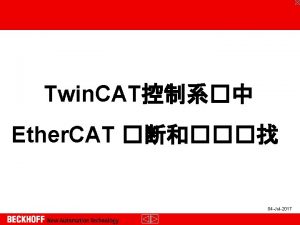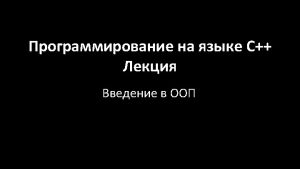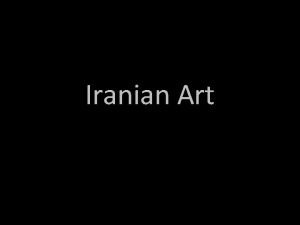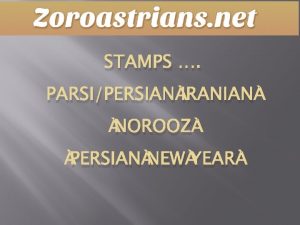Iran Islamic Fundamentalism Map The Persian Cat Iranian

































































































































- Slides: 129

Iran Islamic Fundamentalism

Map: The Persian Cat

Iranian Oil Resources

History of Iran • In 1921, an Iranian military officer took power claimed the old Persian title of “Shah”, or king. • In 1941 the Shah’s son took control who was an ally to the United States and Britain. He also wanted to modernize Iran.

Iran and the Cold War • During WWII, Iran was an ally of the Nazis. • So the USSR and Britain invaded the country in 1942 in order to secure oil fields. • Following WWII, the Soviet Union refused to leave Iran • Until 1946, when the United States threatened to invade Iran and remove the Soviets by force.

Pahlavi Dynasty (1925 -1979) • Ruled Iran from the crowning of Reza Shah Pahlavi in 1925 to the overthrow of Reza Shah Pahlavi's son Mohammad Reza Pahlavi in the Iranian Revolution of 1979. • By the mid-1930 s Reza Shah's dictatorial style of rule caused dissatisfaction among some groups • Dynasty collapsed following widespread uprisings in 1978 and 1979. • Its collapse marks a break in the ancient tradition of Iranian monarchy.

1953 American Coup in Iran

1953: “Operation AJAX” In 1953 the CIA staged a coup d’etat in Iran, overthrowing the constitutionally elected government of the Iranian Prime Minister, Dr. Mossadegh. See Mark Gasiorowski, 1987, “The 1953 Coup D’ Etat in Iran, ” International Journal of Middle East Studies, 19, 26186. James Risen, “Secrets of History: The CIA in Iran, ” The New York Times, Sunday April 16, 2000. Stephen Kinzer, All the Shah's Men: An American Coup and the Roots of Middle East Terror, 2003. Sasan Fayazmanesh, “In Memory of August 19, 1953: What Kermit Roosevelt Didn’t Say, ” Counter. Punch, August 18, 2003. Mossadegh at the UN, 1951

Dr. Mohammad Mossadegh, (There two spellings § Became Prime are Minister in 1951. of his last name…)Prime § Nationalized. Minister the of Iran foreign oil companies. § Got rid of corrupt military officials. § Was toppled in a coup aided by the America CIA in 1953. § The Shah of Iran returns to power. Q 4

EVENT: 1953 CIA coup overthrew Mossadeq • CIA and British intelligence (MI 6) worked together to overthrow the popularly elected Iranian Prime Minister Mohammed Mossadeq

CAUSES: 1953 CIA coup overthrew Mossadeq • Mossadeq nationalized (government controlling) the Iranian oil industry, shutting out the British oil companies who previously profited from it. • When Britain boycotted (refused to buy) Iranian oil, Iran sold oil to the Soviet Union • These moves made Mossadeq look like a Communist to American President Eisenhower (COLD WAR!) • The CIA and MI 6 (British Intelligence) plotted to overthrow Mossadeq • (watch video)

EFFECTS: 1953 CIA coup overthrew Mossadeq • Shah given more power in Iran, but became increasingly paranoid • Shah began a program of modernization and westernization • Shah was allied with the US, and the US supported the Shah • Britain regained access to Iranian oil

The Coup • 1953 -Prime Min Mohammed Mossadeq was overthrown by CIA organized coup • Iranians argue the 1953 coup and US support for the shah were responsible for the shah's arbitrary rule -Led to the deeply anti-American character of the 1979 revolution • “We like to forget the history, Iranians don't. In 1953, The United States and Britain overthrew the parliamentary government of Iran and installed a brutal dictator. In 1979, the population overthrew the dictator. And since then the United States has been essentially torturing Iran: First tried the military coup and then supported Saddam Hussein during Iraq’s invasion of Iran which killed hundreds of thousands of people and after that United States started imposing harsh sanctions on Iran. -Noam Chomsky, The Real News (November 2007)

With the help of British agents, the CIA brought back the self-exiled Mohamed Reza Shah.

What followed was a cozy and symbiotic relationship between the US and the Shah for a quarter of a century.

For the US, the relationship meant: • Economically, the Shah maintained the interests of the US corporations, particularly the oil companies, aerospace industry, and financial institutions. • This included recycling petro-dollars into purchasing military goods and Eurodollar deposits (by the mid 1970 s, the Shah was the largest buyer of US military goods).

It should be noted that in the 1970 s, the US told the Shah to expand Iran’s non-oil energy base by building a number of nuclear power plants. One such plant, which started to be built in the mid 1970 s is in Bushehr:

On your Left Side, examine this picture and answer the question. Here’s a picture of the Shah having a drink with American President Carter. Think about this image. What would a devout Muslim in Iran think about it? Why?

• On your Left Side, answer: • What do you think about the United States and CIA involvement in Iran? Why?


Shah Reza Pahlavi (r. 1941 – 1977) § Institutes Western reforms & ties with the West. § But, the majority of his people live in poverty. § Brutal suppression of dissidents SAVAK Q 5

Politically, the Shah acted as the gangster of the Persian Gulf, stifling any aspiration for independence or democracy (e. g. , he put down the revolutionary movement in Dhofar in 1973 -76). “His Majesty” Sultan

For the Shah, the relationship meant maintaining an absolute monarchy combined with a theater of the absurd.

For the Iranian populace, the relationship meant: § An uneven economic development, characterized by corruption, waste, skewed income distribution, and ultimately high rates of unemployment and inflation by the late 1970 s. § A dictatorship characterized by: ü Lack of the most basic freedoms, including the freedom of expression, speech, and organization, ü The existence of massive secret police (SAVAK) trained and maintained mostly by the CIA & Israeli Mossad, ü Jails overflowing with political prisoners, ü Disappearances, torture, and executions.

The Shah & His Wife, Farah Iranian elite/upperand intellectual classes: very pro-

“The White Revolution” The Shah’s Reform Program (1963) 1. Land reform – 90% of Iran’s peasants became land owners. 2. Massive government-financed heavy industry projects. 3. Granted women more political power – the right to vote. 4. Poured government money into education – especially in rural areas where illiteracy was very high. 5. Profit-sharing for industrial workers. 6. Nationalization of forests and pasture lands.

The Shah at George Washington’s Home, 1950 s

The Shah with Several American Presidents

Note that the US had no problem with the lack of basic human rights in Iran. Even as late as 1978, on the eve of the Iranian Revolution, President Carter, the champion of “human rights, ” traveled to Iran and said:

“Iran island of stability in one of the more troubled areas of the world. This is a great tribute to you, Your Majesty, and to your leadership and to the respect, admiration and love which your people give to you. There is no leader in the world for whom I feel such deep gratitude and personal friendship as the Shah. ” The New York Times, January 1, 1978.

The Shah with President Jimmy Carter

On your Left Side, answer: • What aspects of the Shah’s rule violated the beliefs and practices of Islam? • Why would these actions lead to the rise of Islamic Fundamentalism in Iran?


An “island of stability, ” Iran was not! In 1979, Iran exploded in revolutionary turmoil. Masses of people, from every segment of society, poured into the streets to end the rule of the Shah.

Iran: Iranian Revolution • Unfortunately for Shah Reza Pahlavi, Pahlavi the modernization programs were unpopular. • In 1979, he was overthrown during the Islamic Revolution.

Reasons for the Fall of the Shah The Shah spent the oil profits for top of the line American military hardware. § Little money to reinvest back into the Iranian economy. § Religious leaders angry with the Shah for too much “Westernization. ” § Government corruption. § The Shah’s constitutional violations of the basic human rights of his citizens. §

CAUSES: 1979 Islamic Revolution in Iran • The Shah used violence, torture, and the SAVAK (secret police) to remain in power • The economy worsened • Many Iranians wanted to return to a democratic government • The Shah’s reforms insulted devout Muslims • Ayatollah Khomeini preached revolution in mosques (the “Cassette Revolution”)

Anti-Shah Protests

Shah’s dictatorial rule had managed to eradicate effectively every organized opposition to his rule except one—the clergy whose lives were intertwined with the fabric of the society.

Thus, when in 1979 Iran exploded, one organized force managed to come out on top—the clergy, led by one exiled grand Ayatollah, Khomeini.

Opponents of the Shah 1. Oil field workers 2. 3. 4. 5. • On your Left Side, Students and other • Why do you think intellectuals each of these groups Middle class had issues with the businessmen Shah’s reign? Iranian nationalists • Explain and give Muslim clerics (Cleric is examples. a member of the clergy or religious figure in Islam; like a priest for Catholics or a rabbi for Jews. )

Anti-American Pin (1960 s) • On your Left Side, answer: • What cause of the Iranian Revolution does this political button address?

Iranian Students Protest in Beverley Hills

Anarchy & Revolution The Shah leaves Iran on 1/16/79. Facing likely execution should he return to Iran, he died in exile in Egypt, whose President, Anwar Sadat, had granted him asylum

In the showdown between the Shah and Khomeini, the former lost. He went into exile once again and after traveling about for a while, he arrived in the US for “medical care. ”

Ayatollah Khomeini (r. 1979 -1989) § 1902 – 1989. § Became an Islamic scholar (studied in Qom). § Began to speak out against the Shah in the 1960 s. § Arrested and imprisoned several times by the Shah. § Deported in 1978 & went to France.

Ayatollah Khomeini Leads the Revolution Khomeini returns to Iran on Q 7

Islamic Fundamentalism and Theocracy in Iran

Islamic Revolution (1979) • Transformed Iran from a monarchy under Pahlavi dynasty to an Islamic republic under Ayatollah Ruhollah Khomeini, the leader of the revolution and founder of the Islamic Republic. • It has been called the third great revolution in history • Helped make Islamic fundamentalism a political force • Constitution based on rule by Islamic jurists – Khomeini—Supreme leader (lifetime appointment) – President—Head of the Government – Cabinet – Supreme Court – Legislation

EFFECTS: 1979 Islamic Revolution in Iran • Shah fled Iran, took his money with him! • Ayatollah Khomeini returned to Iran • Iran became an Islamic theocracy, ruled by Sharia Law • The new government was anti-American (“The Great Satan”) and anti. Israeli • Hostage crisis and the Iran-Iraq War

Triumphant Muslim Clerics & Iranian Soldiers A theocracy is created! Q 8

SAVAK Suspects Taken

The Fate of the Shah’s Generals


Iranian Revolutionary Poster • The caption reads: When the devil leaves, the angel returns! • On your Left Side: What changes does this poster specifically refer to? Explain.

On your Left Side, • Design your own political button for in support of the changes made by the Ayatollah.

American Hostages Crisis

Iran: Takes American Hostages • Iran’s new government set up an Islamic Republic. • Relations with the United States broke down. • In 1979, a mob of Iranian students took Americans hostage.

Iran: Takes American Hostages • The Iranian government gave permission for the Americans to be taken hostage. • The Americans were held by force for over 1 year.

Shah’s arrival in the US triggered “students following the line of Imam” to attack the “nest of spies, ” the US Embassy, in November 1979 and take 52 Americans as hostages in exchange for the Shah.

American Embassy in Tehran Taken Over Q 9

52 Americans Held Hostage for 444 Days!

On your Left Side: • Imagine you were one of the hostages. What do you think was going to happen to you based upon the recent events of the Iranian Revolution? • Explain.

President Carter Becomes a Hostage, Too

Hostage Rescue Disaster

A few days after the takeover of the US embassy, the Carter Administration invoked the International Emergency Economic Powers Act (IEEPA) to freeze all Iranian government assets and properties. This act was initially instituted in 1977 to protect the interest of US corporations, particularly the financial institutions, such as the Chase Manhattan Bank.

After many months of negotiations, the US and Iran signed the Algiers Accord in 1980, setting up the Hague Tribunal to settle all financial claims between the US and Iran agreed to release the hostages and pay reparations to the US corporations. The US agreed to unfreeze the Iranian assets and not to interfere in Iran’s affairs again. Alerassool, M. (1993). Freezing assets. New York: St. Martin Press. Fayazmanesh, S. (2003). “The Politics of US Economic Sanctions, ” Review of Radical Political Economics.

52 American Hostages Released in Jan. , 1981

1980 s—strained time with US • 52 U. S. diplomats held hostage by group of Iranian terrorists who took over American embassy in support of the Islamic revolution. • 444 day hostage crisis ended in 1981 • The incident was seen by many as a blow against U. S. influence in Iran and its support of the recently fallen Shah of Iran, Pahlavi, who had recently been allowed into the United States for cancer treatment. • In Iran, the crisis is thought to have strengthened the political hold of radical anti-American forces who supported the hostage taking. • The crisis also marked the beginning of American legal action, or sanctions, that weakened economic ties between Iran and America.

EFFECTS: 1979 Iran Hostage Crisis • Anti-Iranian feeling in US (sale of Iranian flags actually increased!) • President Carter seen as having failed to gain release of hostages • Conservative Republican President Ronald Reagan won 1980 Presidential election in US • Hostages released on Reagan’s inauguration in exchange for $8 billion ($5 billion was used by Iran to pay debts to US anyway) • Khomeini needed money with war against Iraq looming

In 1980 the US government, led by Zbigniew Brzezinski, started a new policy that would later be called the “dual containment policy. ” This policy consisted of trying to “contain” both Iran and Iraq economically and militarily in favor of the US’s client states in the region, mainly Saudi Arabia and Israel.

Iran-Iraq War Will go more in depth when we cover Iraq

The Islamic Revolution & the Iran Iraq War § 1979 to 1981 § Competition for power; violence § Khomeini gains the upper hand began instituting Islamic law in all spheres of public life. § Iran-Iraq War § Legacy of Oil Wealth: A Rentier State § Sustain themselves independently of social pressures and powerful interest groups

The relationship between Iran and Iraq had been a stormy one during the Shah’s reign. § The Shah had tried to destabilize the Iraqi government in 1972 on behest of the US and Israel. § Iraq had territorial claims over entire Shatt al-Arab (Arvand river) Saddam Hussain and the Shah of Iran during the Algiers Agreement, 1975

§ It appears that the Carter Administration, and in particular, Zbigniew Brzezinski, used the tense relation between Iraq and Iran to start a war between the two. § Both Carter (Keeping Faith: Memoirs of a President) and Brzezinski (Power and Principle: Memoirs of the National Security Advisor, 1977 -1981 ) deny this accusation. § Actually, when Iranians first made such allegations, many months before Saddam’s invasion of Iran, Brzezinski called them “lunatic assertions. ” § But there is plenty of evidence to show that the Carter Administration played a great role in starting the war:

But even without access to official documents, one can show by reading the US and European newspapers of the time that Iranian allegations were not “lunatic assertions” and that the US: 1) Intended to overthrow the Iranian government and, as such, was warming up to Saddam Hussein even though Iraq was on the list of “terrorist states, ” 2) Saw the war as a possible way of releasing the US hostages, and 3) Used Iranian exiles, such as the former general of the Shah, Oveissi, as a go between to carry messages to Saddam and to encourage him to attack Iran.

Note: General Gholam Ali Oveissi, Shah’s former ground forces commander, “on Sept. 8, 1978, opened fire on an anti-shah demonstration, killing hundreds in what has come to be known as the Black Friday massacre” (The Washington Post, May 17, 1980).

In September of 1980 Saddam declared Shatt al-Arab “totally Iraqi and totally Arab” and invaded Iran. He further claimed that 3 Islands in the Persian Gulf belong to Iraq.

President Carter declared “strict neutrality in the conflict ”on the part of the US. However: The US rushed to help Saddam by sending § 4 AWACS and § a number of support personnel to Saudi Arabia 6 days after Saddam’s invasion. Saudi Arabia and Kuwait were the main allies and financiers of the Saddam Hussein.

The Iran-Iraq war was one of the longest, costliest and most brutal wars of the 20 th century. It lasted 8 years and was conducted in the style of WWI, using masses of people in the trenches.

In late 1983 Saddam, unable to win the war, started to use chemical weapons against the Iranians and, later on, against Iraq’s own Kurdish population.

Question: Who supplied Saddam with chemical weapons and gave him the green light, to use them? Answer: The United States of America. It has now become common knowledge that: § the US supplied much of what Saddam needed in building chemical weapons, including anthrax (see, for example, Denver Post, October 10, 2001, Washington Post, December 30, 2002). § Donald Rumsfeld, the Middle East envoy, met Saddam right after the first use of chemical weapons. Video: Saddam-Rumsfeld December 20, 1983, Meeting: http: //www. gwu. edu/~nsarchiv/NSAEBB 82/ §

Yet, despite all US help, Iraq could not win the war. Thus, when in 1986, Iran scored victories in Iraq’s Faw peninsula, the US engaged Iran directly. For example: § it re-flagged Kuwaiti ships, § it sunk Iranian boats and oil platforms, and § USS Vincennes shot down an Iranian civilian plane, killing 290 on board.

The shooting down of the Iranian civilian airliner by the US was the beginning of the end of the Iran-Iraq War. Iran reached the conclusion that they could not win a war against the US and Iraq. They therefore accepted a ceasefire in 1988. Note that all US actions were contrary to the Algiers Accord.


The Khomeini Revolution

Current Policy Challenges § Iran is the first country in which Islamists have had to deliver on the promises of a society characterized by social justice and moral propriety. § During the first decade of the Islamic Republic § Some redistribution of wealth § New leadership came mostly from humble or middle-class backgrounds and adopted populist policies that somewhat bettered the lot of the poorest. § § Rural development Health Women’s education Roads § Poverty, inequality, and underemployment continue to be major public grievances.

Current Policy Challenges § Job creation has been very inadequate. § Need to increase economic output. § Population grows by one million a year. § Discontent spurred out migration from the country § One in four Iranians with higher education live abroad § Subsequently, Iranians often have family abroad in the U. S. , Canada, and Europe § Corruption § Dissatisfaction with the status quo among some of Iran’s ethnic minorities

Women in Iran A woman’s hijab represents her Islamic and moral values.

Political Cartoon Commentary On your Left side: What is the message of this political cartoon? Explain. The dictatorship is gone! Bring on the dictatorship!

Support for the Palestinian Cause Funds Hamas and Hezbollah. The Ayatollah with Yasir Arafat.


Khomeini’s Death (June, 1989)

Iran: Government

Institutions of the Islamic Republic § Multiple power centers § Leader § Highest authority in the Islamic Republic § Combines religious and temporal authority § Assembly of Experts § Choose the Leader § President § Elected by universal suffrage every four years § Must be a Twelver Shiite and a male; does not have to be a cleric

Iran: Government • Iran is a theocracy – a government ruled by religious leaders.

Background: Islamic Republic of Iran § World’s only theocracy § A form of government in which ideally all laws are grounded in religion and express the will of God, and the clergy exercises supreme power

Iranian Supreme Leader Ayatollah Ali Khamenei The Ayatollah represents the fundamentalist Mullahs.

Iran: Government • An expert on Islamic law is the supreme leader.

Ayatollah Khatami The Ayatollah is considered a political moderate. Q 12

Support for the Shi’ites in Iraq Today Moqtada al-Sadr, radical Shi’ite leader in Fallujah, Iraq

The State of the Union Address 29 January 2002 “States like these [North Korea, Iran, and Iraq] and their terrorist allies, constitute an axis of evil, arming to threaten the peace of the world. By seeking weapons of mass destruction, these regimes pose a grave and growing danger. They could provide these arms to terrorists, giving them the means to match their hatred. They could attack our allies or attempt to blackmail the United States. In any of these cases, the price of indifference would be catastrophic. ”

Iranian Relations with Western Nations • Today there are no formal diplomatic relations between Iran and The US • Do not exchange ambassadors -Iran maintains an interests section at the Pakistani embassy in Washington D. C -US maintains an interests section at the Swiss embassy in Tehran

Hostility • Hostility begins after the 1979 Iranian Revolution • US fears that Iran is developing nuclear weapons shortly after the Revolution • 1995 -the United States starts an embargo on trade with Iran • US District court judge says that the Iran was responsible for the 1983 attack on US Embassy • US Fed court finds Khobar Towers bombing was authorized by Ali Khomeini -Ayatollah of Iran • United States attack of 1988 -United States launched Operation Praying Mantis against Iran -Largest American naval combat operation since World War II

Iranian Nuclear Program • Since 2003 the US has alleged that Iran has a program to develop nuclear weapons • Iran says that its nuclear program is only to generate electricity • Both US and Iran are members of NPT -US and other countries in violation for not disarming -Iran in violation for not reporting nuclear material to IAEA • March 8 2006 -US and European countries call on Security Council of UN to act against Iran

Brief Iran Nuclear Program History • Atoms for Peace program • Iranian Revolution – Iraq war • Iran Program 2000 – present – In 2003 President Mohammad Khatami announcement of building sophisticated facilities at Natanz and other places – EU-3 • Pushing Iran to sign the Additional Protocols • Paris Agreement – In 2006 Iran reduces inspection rights of IAEA – Sanctions

Political Culture • Authoritarianism (not totalitarianism) – leaders claim to be all powerful, but do not interfere with every aspect of the citizens lives • Union of political & religious authority • Shi’ism & Sharia – key components of everyday life • Geographic Limitations – limited arable land forced expansion through military conquest, population of Iran unevenly distributed in cities and northwestern part of country • Influence of Ancient Persia and colonial past

Iran: Government • Iran has an elected president and legislature (chosen by the spiritual leader).

Akbar Hasemi Rafsanjani • Two time Iranian president • Decided to revive nuclear program in 1980’s • Lost to Ahmadinejad in 2005 election • Seeks to cooperate with UN regarding nuclear program

Mahmoud Ahmadinejad Born 1956 Engineer, Party: Alliance of Builders of Islamic Iran Elected mayor of Tehran in 2003 Won ~60% of the popular vote in 2005 presidential election Outspoken and often controversial for his views on Israel, the US, Great Britain, and human rights

Mahmoud Ahmadinejad • • Sixth Iranian President Rose to power in 2005 Staunch opponent of US and Israel Hard stance on belief that Iran should possess nuclear weapons

Supreme Leader Ali Khamenei • Lost 2009 election to Ahmadinejad • Rarely speaks about nuclear program • When he does, he disagrees with Ahmadinejad’s stance, calling it costly

The Summer 2009 Elections (June 12) Candidates Ahmadinejad and Mir-Hussein Mousavi receive 62% and 34% of the popular vote, respectively Public outcry came against wide-spread accusations of voting irregularities Video Commentary – This link is one of a HUGE amount of material on this election available online. The elections were Tweeted, Facebooked, 24 hour news networked, commented, Wikied, Huffington Posted, and more! – A little online digging goes a long way.


On your Left Side, answer: CARTOON 1: Is this cartoon in support of Ahmadinejad or Mousavi? What does the cartoon suggest about the government in Iran?


On your Left Side, answer: Is this cartoon in support of Ahmadinejad or Mousavi? Who are the bearded men in black meant to symbolize? What is the skeletal remains of the horse meant to represent? What does the artist imply about the reform movement’s opinion of the United States?


On your Left Side, answer: Is this cartoon in support of Ahmadinejad or Mousavi? What does the cartoon suggest about the role of the Supreme Leader in the election? Who or what is the “loser” according to the cartoon? What does this cartoon imply about democracy in Iran?


Iran: Governmental Policies • Iran’s government has supported many hardline policies. • For example: call for the destruction of Israel • For example: supported terrorist groups

Another Nuclear Power? US satellite photo of Iranian nuclear facility near Arak.

Game Theory

An American view of Iranian nuclear power: What children’s story is this political cartoon playing off of? PINOCCHIAYATOLLAH Scott Stantis (Birmingham News) 1/28/05

A view of Iran’s nuclear power from Al-Jazeerah Nobody else (particularly Iran and Arab countries) should have nuclear weapons except Israel, says Bush. -- Hassan Bleybel 10/23/03

On your Left Side, • What is the cartoonist’s main point or position in the following political cartoon? • How do you know?


A “Shah” in the Waiting? Reza Pahlavi (III? ), 43 year-old son of the deposed Shah.

Iranian Demographics • Population—nearly 70 million • Life expectancy at birth — 69 years • Birth rate— 17 per 1, 000 persons • Death rate— 6 per 1, 000 persons • Literacy rate— 72%
 Iran cat map
Iran cat map Cat 1 cat 2 cat 3 aviation
Cat 1 cat 2 cat 3 aviation Ils cat 1 minima
Ils cat 1 minima Religious fundamentalism ap world history
Religious fundamentalism ap world history What is ethical fundamentalism
What is ethical fundamentalism Gregory is my beautiful gray persian cat
Gregory is my beautiful gray persian cat On one corner of my dresser sits a smiling toy clown
On one corner of my dresser sits a smiling toy clown Iranian revolution timeline
Iranian revolution timeline حسابدار رسمی
حسابدار رسمی Indo iranian languages
Indo iranian languages Censoring an iranian love story
Censoring an iranian love story Iranian coup apush
Iranian coup apush Ey anthem
Ey anthem Which number on the map represents the yangtze river?
Which number on the map represents the yangtze river? Cyrus map
Cyrus map I bought me a cat and the cat pleased me
I bought me a cat and the cat pleased me Islamic empire map activity answer key
Islamic empire map activity answer key Islamic schools of thought map
Islamic schools of thought map Satrapy of iran
Satrapy of iran Iran hostage crisis timeline
Iran hostage crisis timeline Iran prebivalstvo
Iran prebivalstvo What was iran known as before 1935?
What was iran known as before 1935? Iran'la sınırımızı belirleyen antlaşma
Iran'la sınırımızı belirleyen antlaşma William knox d'arcy
William knox d'arcy Jessica hana
Jessica hana Oliver north iran contra affair
Oliver north iran contra affair Language in iran
Language in iran Plastic omnium h300
Plastic omnium h300 I must go home to iran again
I must go home to iran again Export development bank of iran
Export development bank of iran Cuándo será el arrebatamiento de la iglesia
Cuándo será el arrebatamiento de la iglesia Tormento eterno versículos
Tormento eterno versículos Verbos con 9 letras
Verbos con 9 letras The voice iran
The voice iran The shepherd lived in
The shepherd lived in When did iran gain independence
When did iran gain independence Iran construction engineering organization
Iran construction engineering organization Razboiul iran irak
Razboiul iran irak Iran
Iran Iran population
Iran population Iran
Iran Iran
Iran Iran cyber
Iran cyber Garamol
Garamol Squeeky fromme
Squeeky fromme Arezou khorramdin
Arezou khorramdin Abdollah arefkia
Abdollah arefkia Iot iran
Iot iran Iran azeri bölgesi
Iran azeri bölgesi Dba iran
Dba iran Iran ap comparative government
Iran ap comparative government Iran doostan
Iran doostan Persian wars timeline
Persian wars timeline Persian wars timeline
Persian wars timeline The rise of the persian empire
The rise of the persian empire Nonius datus
Nonius datus Persian wars timeline
Persian wars timeline Persian worship songs
Persian worship songs Qanats definition
Qanats definition Define persian wars
Define persian wars How did persian rulers unite their vast empire?
How did persian rulers unite their vast empire? Persian wars cause
Persian wars cause The persian empire chapter 4 section 3
The persian empire chapter 4 section 3 Cambysus
Cambysus Unang grupo ng mga tao na nakatuklas ng gulong.
Unang grupo ng mga tao na nakatuklas ng gulong. Chapter 4 section 3 the persian empire
Chapter 4 section 3 the persian empire Persian empire trade routes
Persian empire trade routes Persian chart
Persian chart Persian art
Persian art Persian royalty
Persian royalty Persian royal road
Persian royal road Chapter 4 section 3 the persian empire
Chapter 4 section 3 the persian empire Persian wars definition
Persian wars definition Persian empire primary sources
Persian empire primary sources Mazdaism religion
Mazdaism religion Persian army
Persian army Persian wars
Persian wars Which marked the end of the peloponnesian war
Which marked the end of the peloponnesian war Persian
Persian Persian aqueducts
Persian aqueducts Three basic teachings of hinduism
Three basic teachings of hinduism Persian gulf conflict
Persian gulf conflict Cause of persian war
Cause of persian war Persian empire golden age
Persian empire golden age Hát kết hợp bộ gõ cơ thể
Hát kết hợp bộ gõ cơ thể Frameset trong html5
Frameset trong html5 Bổ thể
Bổ thể Tỉ lệ cơ thể trẻ em
Tỉ lệ cơ thể trẻ em Chó sói
Chó sói Thang điểm glasgow
Thang điểm glasgow Hát lên người ơi
Hát lên người ơi Các môn thể thao bắt đầu bằng tiếng chạy
Các môn thể thao bắt đầu bằng tiếng chạy Thế nào là hệ số cao nhất
Thế nào là hệ số cao nhất Các châu lục và đại dương trên thế giới
Các châu lục và đại dương trên thế giới Công thức tiính động năng
Công thức tiính động năng Trời xanh đây là của chúng ta thể thơ
Trời xanh đây là của chúng ta thể thơ Mật thư tọa độ 5x5
Mật thư tọa độ 5x5 Phép trừ bù
Phép trừ bù Phản ứng thế ankan
Phản ứng thế ankan Các châu lục và đại dương trên thế giới
Các châu lục và đại dương trên thế giới Thể thơ truyền thống
Thể thơ truyền thống Quá trình desamine hóa có thể tạo ra
Quá trình desamine hóa có thể tạo ra Một số thể thơ truyền thống
Một số thể thơ truyền thống Cái miệng nó xinh thế
Cái miệng nó xinh thế Vẽ hình chiếu vuông góc của vật thể sau
Vẽ hình chiếu vuông góc của vật thể sau Thế nào là sự mỏi cơ
Thế nào là sự mỏi cơ đặc điểm cơ thể của người tối cổ
đặc điểm cơ thể của người tối cổ Thế nào là giọng cùng tên?
Thế nào là giọng cùng tên? Vẽ hình chiếu đứng bằng cạnh của vật thể
Vẽ hình chiếu đứng bằng cạnh của vật thể Tia chieu sa te
Tia chieu sa te Thẻ vin
Thẻ vin đại từ thay thế
đại từ thay thế điện thế nghỉ
điện thế nghỉ Tư thế ngồi viết
Tư thế ngồi viết Diễn thế sinh thái là
Diễn thế sinh thái là Dot
Dot Số nguyên tố là gì
Số nguyên tố là gì Tư thế ngồi viết
Tư thế ngồi viết Lời thề hippocrates
Lời thề hippocrates Thiếu nhi thế giới liên hoan
Thiếu nhi thế giới liên hoan ưu thế lai là gì
ưu thế lai là gì Sự nuôi và dạy con của hổ
Sự nuôi và dạy con của hổ Khi nào hổ mẹ dạy hổ con săn mồi
Khi nào hổ mẹ dạy hổ con săn mồi Sơ đồ cơ thể người
Sơ đồ cơ thể người Từ ngữ thể hiện lòng nhân hậu
Từ ngữ thể hiện lòng nhân hậu Thế nào là mạng điện lắp đặt kiểu nổi
Thế nào là mạng điện lắp đặt kiểu nổi Define islamic art
Define islamic art Largest islamic empire
Largest islamic empire Masuliyyah
Masuliyyah Islamic accepted bills
Islamic accepted bills
